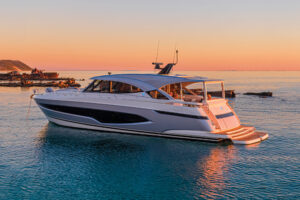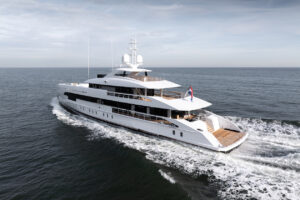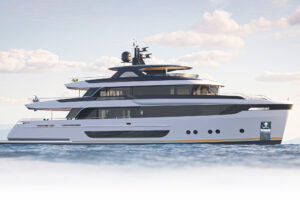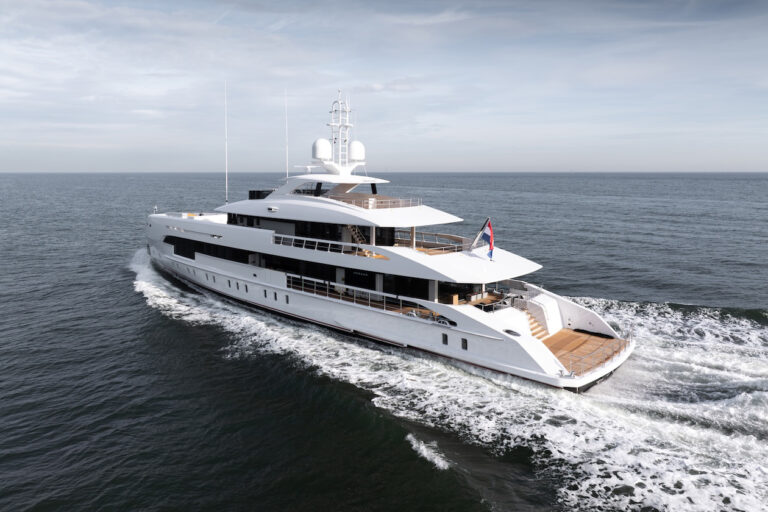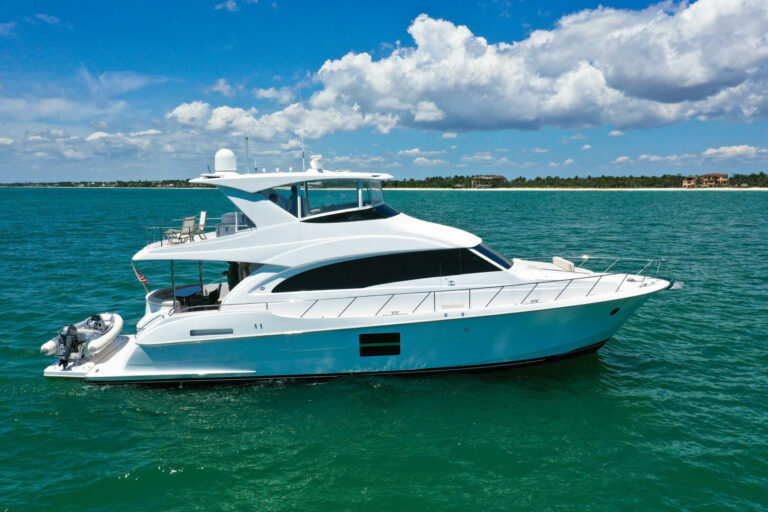If Wallygator, the first of Luca Bassani’s brainchildren, was a breath of fresh air when it appeared on the sailing scene in the waning years of the last century, the Wallypower 118 motoryacht is a full gale. On the outside, she combines elements of Marcello Gandini’s masterpiece Lamborghini Countach of the middle 1980s and the U.S. Air Force Stealth Fighter. On the inside, she reinforces Bassani’s predilection for simple, open spaces defined by areas of use, instead of bulkheads. Bassani, il padrone of Wally Yachts, didn’t design the 118, but his signature is all over it.
Like the Countach and the Stealth Fighter, this 118-foot speedster is a riot of hard edges, straight lines and serious functionality. Her extraordinary elegance and simplicity suggest a child of 10 could have produced her topsides and house, but these elements are the work of modern artists set free from the shackles of traditional thinking about how boats should look.
As far as I can tell from the drawings, only one of the design elements above the waterline exists purely for its own sake. Everything else serves a purpose. The sheerline in profile is reversed, higher amidships than at either end. This is typical of high-performance boats and had its origin in an attempt to make the topsides aerodynamic. The Wally’s recessed deck kills that theory, so we have to regard the reverse sheer as a styling exercise that places the 118 in the high-performance category.
We could easily dismiss the prominent side pods as a gimmick, mostly because we’re so used to seeing fake scoops and vents on modern automobiles and boats. These, however, are real. They draw, via the forward opening, mega-volumes of fresh air to the gas turbine engines, and they house the exhaust system. The top section of each pod (above deck height) hinges outboard to become a teak-paved boarding platform served by a ladder/gangplank that appears to slide out of the pod.
As a styling device, the side pods, combined with the rise of the chine from amidships forward, carve the massive topsides area into manageable sections, letting us process her statement at our leisure instead of forcing us to absorb the whole in one glance. The design team’s confidence in the 118’s dramatic statement is illustrated by the choice of color. The designers rendered her in titanium gray on the topsides and charcoal gray for the house, proudly showing exactly how this sculpture defines itself in shadows and highlights. She may be the only large powerboat in the hyper-performance class that doesn’t need “oh boy” murals on her topsides.
Flat planes at various angles to one another form a deckhouse that reminds me of the Stealth Fighter. Claudio Lazzarini, of the Lazzarini & Pickering design firm, calls it a crystal prism. The entire structure is made of flat transparent panels-flat to permit the use of power-operated doors and windows, and to prevent the distorted view that often comes with transparent curvatures. This crystal prism, the designers said, creates in the saloon the relaxed atmosphere of a cockpit. Tinting the structure filters ultraviolet rays, keeps the interior from being too bright and too hot, and contributes to the yacht’s purposeful look. Decks of natural-finish teak color-a touch of the early 20th century on an otherwise futuristic concept-ease the extreme tension generated by her sharp edges and no-nonsense demeanor.
Teak planes, vertical and horizontal, inside the crystal prism divide the area into a landscape of functions, or islands in a sea of teak. Right abaft the helm, a sliding teak table seats 14 adults in a formal or a casual setting. Among the many islands, one contains a single seat for reading or working at a computer housed in a nearby cabinet. Beneath this chair is a small, drawer-style refrigerator most people would stock with mineral water, soft drinks and beer. Another island lets you stretch out to watch the TV perched atop an end table, which also contains a stereo.
“The navigation area,” Carl Pickering said, “is more similar to a flight deck than its usual nautical equivalent and can be used as an office or dining area, thanks to sliding tables.”
Lazzarini & Pickering continue the system of teak planes belowdecks to create the corridors and staterooms, though details about the area weren’t available. Outside, the teak theme appears in the after cockpit and a playpen on the foredeck. Here, we find picnic tables that retract flush with the deck, forming a sunbathing area.
The 118’s hull is narrow monohull with training wheels. It has its roots in high-speed naval craft and, as far as I can determine from the renderings, marries an extremely fine entry to an inverted W-shape planing surface. The design team volunteered only that the bow sections reduce vertical accelerations by 50 percent. This means a relatively smooth ride in a seaway. Her fine entry will split the waves, but the bow sections will gain buoyancy as the high chines dig into the water. By this time, most of the energy will have dissipated, so the crew won’t get slammed into the cabin sole. If I were drawing this bottom, I’d make the chine area a tunnel of something close to a semicircle. Ridding the bottom of flat surfaces reduces pounding. On the other hand, a flat surface at the planing area, which won’t leave the water, creates lift, so let’s look for a delta-shape flat way back aft.
Wally expects a top speed of 70 knots from the 118’s four engines-a pair of gas turbines and two diesel auxiliaries-turning two KaMeWa waterjets. I call the diesels auxiliaries because the helmsman will use them for low-speed maneuvering, turbines disengaged, and cruising at very low speeds. Each turbine/diesel duet couples to a clutched transfer box, which permits running one or both engines each side. This, too, is common on military craft.
If my assumptions about the bottom are skewed, I’ll be the first to admit it, but we’ll have to wait until hull number one splashes or I see her under construction. I do know the shape benefits from extensive tank testing.
Wally expects to launch hulls one and two during 2002. Right now, though, I think the Wallypower 118 is the most significant design of the past 14 years, the period I’ve devoted to studying how boats work and why. Like all brilliant works of art, functional or decorative, the 118 defies a simple interpretation. Her statement is far too powerful to permit any observer to settle on a middle ground. They’ll love her or hate her.
Let me be the first to say, “I love this design.”
Contact: Wally Yachts, (011) 377 93 1000 93; fax (011) 377 93 1000 94; sales@wallyyachts.com; www.wallyyachts.com.

